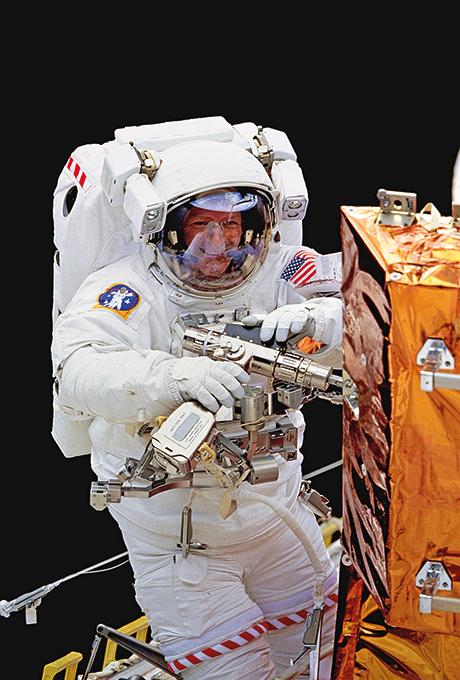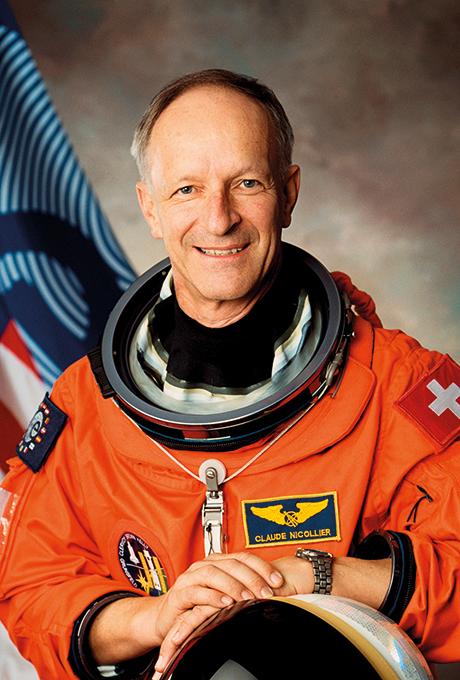Claude Nicollier: ‘UAE has achieved a lot as a young space nation’
The pioneering Swiss astronaut, who was part of the team that fixed the Hubble Telescope in space, tells Anand Raj OK how they carried out the task, the beauty of earth from space and why he thinks the UAE has a bright future in space science
Five minutes, says Claude Nicollier. “That’s the time Nasa had given us to get acclimatised to outer space before we got working on the task we were assigned. And let me tell you five minutes is very short.”
The first astronaut from Switzerland who has been on four space missions, Claude is at the Swiss Pavilion at the Expo 2020 Dubai, and the distinguished retired captain, in an exclusive interview, is recalling the time he was on a space mission that included making crucial repairs to – and carrying out maintenance of – the Hubble telescope in 1993.
The repair involved replacing a pointing camera to correct an error in the telescope’s lens that caused significant image distortion while the maintenance included exchanging the main computer on the telescope. This meant he and a teammate would be spending close to eight hours in space, tethered to the shuttle by a cable not unlike an umbilical cord.
Cheerful and belying his age of 77 years, the avuncular gentleman sits ram rod straight in his chair, while recalling his time in space. Then a captain of the Swiss Air Force, he remembers emerging from the airlock of the Space Shuttle and preparing for a spacewalk some 550km high above the earth. It was the second time he was in space but the first time he would be making a space walk.
“There were two of us – there are always two persons on such missions,” he recalls. “I was the first to step outside [the Space Shuttle] into space and when I looked around, it was a very special moment. But at the same time you should avoid getting too emotional; you just need to do your job. You cannot afford to get philosophical.”
Up above the world so high...
The astronaut was well aware of the spectacular sights of the Earth and the stars that were possible from the exclusive and privileged viewpoint that he had in space. But he also knew that he had to remain focussed on the task at hand. “Space walk is so tight on time that [Nasa] doesn’t want you to lose valuable minutes looking around,” he says, with a laugh.
I am keen to know all about what he saw in and from space and ask him whether he did take some time off to look around and admire the stars.

“No, during the space walk I did not,” says the 6-foot-something ex-Air Force officer. “We were very focussed on the work – we need to be extremely focussed because there is no room for mistakes. I remember making a few minor ones, later clutching my head and saying, ‘Ahh’. But luckily they were not big mistakes.”
When he could, though, he did steal a few seconds to look down and see the earth spinning. “I remember one time we were flying over Egypt and the view was brilliant. There were no clouds at the time and we could see the Red Sea, the Nile delta and the floodplains, the Suez… It’s truly an unbelievably amazing sight! You look at this for maybe 10 seconds then get back to work because you would be irresponsible to spend so much time in space and not accomplish what you set out to do – your mission.”
Going around the world every 90 minutes – a day for him in space lasted one hour and the night half an hour – he was able to see 16 sunrises and 16 sunsets every earth day. “We had a one-minute warning before the sunset because while it is bright by day, within 10 seconds it is night,” he said.
Originally trained as an astrophysicist and a fighter pilot in the Swiss Air Force, he was a team member on four space flights, including two missions to maintain the Hubble Space Telescope. (Claude was one of seven trained to repair the telescope.)
Presently an Honorary Professor at the Swiss Federal Institute of Technology Lausanne, the man who has logged more than 1,000 hours in space is keen to share his knowledge and experience with the next generation. To that end he teaches a course on Space Mission Design and Operations, while providing assistance to students on space-related projects.
In Dubai for the Expo 2020, he attended the Space Week late last year organised by the Swiss pavilion where he also met with experts from around the world. (Incidentally, among the Swiss artefacts at the pavilion are Prof Claude’s own notes from the crew notebook.)
Claude may have been 48 years old when he flew into space for the first time on board the US space shuttle Atlantis after 12 years of training, but from young he nursed a passion for astronomy. “I was fascinated by stars and nature and was always curious about everything asking my parents why the sky is blue, why the sun shines so brightly, how far are stars from the earth...” he says. So when he had to choose a subject to major, astrophysics was but a normal choice.
When he turned 20 and was required to opt for one of the armed services, mandatory for males in Switzerland, he chose the Air Force. Thanks to his aptitude and passion, he was quickly absorbed into the fighter bomber squadron of Switzerland.
“It was a part time activity,” he says. So while his fulltime job was that of an astronomer “every two months I’d spend one week flying four flights a day. It was a great life if you liked science and flying. A wonderful life.”
A passion for flying
All through that time he was also passionately following Nasa’s Apollo program dreaming that one day he too would be able to fly into space. An opportunity for that would come his way when the US invited the European Space Agency (ESA) in the late 70s to develop a scientific lab for the Space Shuttle.
“At around the same time Nasa invited Europe to select astronauts to fly on the Space shuttle,” he says. Three European astronaut candidates were selected for the first time in 1978; Claude was one of them.
From astronomer to astronaut must have been a major leap, I point out.
“Yes,” he says. “I liked the adrenaline rush [I experienced] when flying a jet plane in military aviation. That, combined with being a scientist, made it natural for me to choose astronautics.”
Going into space – and getting to be part of the team to repair the telescope – of course was no cakewalk and involved several months of rigorous training. An exact replica of the Hubble telescope was built in a swimming pool (to simulate a reasonably good feeling of weightlessness) where he and his teammates learnt how to repair it in a fixed span of time. He also had to train for long hours in a 1G environment performing experiments, doing robotic operations and managing the trajectory, among other things.
All about precision
According to Nasa, once the space shuttle was in orbit around Earth, it matched the speed of Hubble’s orbit (around 27,000kmph) to rendezvous with the telescope, capture it with the space shuttle’s robotic arm, and clamp it into the cargo bay while the two astronauts completed extravehicular activities or spacewalks to manually make repairs and installations. The telescope was then released back into orbit.
While flying in the Space Shuttle – “such an amazing machine” – satisfied his passion for aviation, performing scientific experiments and fixing the Hubble – “such a wonderful mission” – was a dream come true for the astronomer turned astronaut.

On his first space trip, Claude was a flight engineer and robotic arm operator; it was on his second trip that he got to step out into space. Walking in space is mentally and physically exhausting, he says. And when it also involves repairing fine instruments in outer space, training and more training is crucial to ensure success.
“The secret to being successful is to train, train and train extensively,” he makes it clear. “In our case, [due to our training] we became very familiar with the tools, with Hubble itself, the airlock and the robotic arm and the way you can move around the fuselage of the Shuttle. You have the safety tethers and you need to manage them so it doesn’t become tangled and this you can do only through rigorous training.”
Although it is close to three decades since he was one of the scientists who fixed the Hubble Telescope, the sense of pride and fulfilment of having made a difference to advance science is still evident in his voice as he recalls the space operations he carried out. “To fix a very valuable instrument in space (for those who came in late, the Hubble mission has cost approximately $16 billion, adjusted for inflation to 2021 dollars, since its official start in 1977) was wonderful,” he says. He underscores that the Hubble missions were special to him not only because they offered him quite literally a new perspective of space but also because they helped him “accomplish something you believe in… serving the scientific community and the public”.
Is he enjoying the time at the Expo 2020 Dubai?
Yes, he says. Claude waxes eloquent on the progress the UAE has made in the field of space and astronomy. “The UAE is such a young space nation and it has achieved a lot,” he says. “Remarkable progress and success for such a young country.”
He mentions a talk he attended at the Expo 2020 Dubai regarding UAE’s achievements in the area of radio astronomy: “I was very impressed by some of the students from the UAE who were discussing the work they were doing [in this field]. I was impressed by their drive, their talents and their ability to communicate. I’ve seen a lot of young people in the UAE who are very bright and I am sure they have a very bright future.”
Claude’s advice for students aspiring to become astronomers and astronauts
“You need to have passion for the subjects,” he says. “Deep passion. Also curiosity. To become an astronaut, you need to have a passion for flying, for science and engineering and the willingness to work hard on spaceships and telescopes. You need to have a passion for achieving in a pretty high risk environment. Mountain climbers, they have that. You also need to hone your ability in taking calculated risks.”
He suggests indulging in such sports as mountain climbing, para jumping or flying acrobatics (of course, with guidance of experts) in addition to training in science and engineering. “You need to do things that have an element of risk and you need to be enjoying it,” he says with a laugh. “If you have passion and normal intelligence, you develop better tools to solve problems in the fields of science and engineering.”